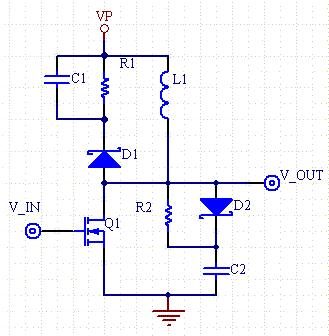boylesg
Advanced Member level 4

- Joined
- Jul 15, 2012
- Messages
- 1,023
- Helped
- 5
- Reputation
- 10
- Reaction score
- 6
- Trophy points
- 1,318
- Location
- Epping, Victoria, Australia
- Activity points
- 11,697
Have settle on this modification of the design:
I tried the TC4422 connected to the 12/24V rail with a 12V zenner diode in parallel with it to protect it but it appears that 24V results in the power rating of the zenner diode being exceeded followed by over voltage on the TC4422. So it would appear that zener diodes are not all that a robust way to protect the TC4422 if you want to increase the input voltage to the fly back transformer.
On the other hand a voltage regulator appears to be a far more robust way of protecting voltage sensitive components, up to a point, as it is a simple matter of attaching an appropriate size heat sink to it.
So I attached a larger than usual heat sink to my 12V voltage regulator and then a much larger heat sink to the top of this, face to face. So I should have a fairly large heat dissipation capacity for it as long as the heat transfers adequately across the junction between the two heat sinks. There is a pad of some sort between them that was mounted under the transistor that was originally attached to the large heat sink on an old tv circuit board - I guess it is an alternative to the thermal paste normally used between the electronic components and heat sinks.
Probably all very obvious to you experts though......but I am just learning.
I tried the TC4422 connected to the 12/24V rail with a 12V zenner diode in parallel with it to protect it but it appears that 24V results in the power rating of the zenner diode being exceeded followed by over voltage on the TC4422. So it would appear that zener diodes are not all that a robust way to protect the TC4422 if you want to increase the input voltage to the fly back transformer.
On the other hand a voltage regulator appears to be a far more robust way of protecting voltage sensitive components, up to a point, as it is a simple matter of attaching an appropriate size heat sink to it.
So I attached a larger than usual heat sink to my 12V voltage regulator and then a much larger heat sink to the top of this, face to face. So I should have a fairly large heat dissipation capacity for it as long as the heat transfers adequately across the junction between the two heat sinks. There is a pad of some sort between them that was mounted under the transistor that was originally attached to the large heat sink on an old tv circuit board - I guess it is an alternative to the thermal paste normally used between the electronic components and heat sinks.
Probably all very obvious to you experts though......but I am just learning.



